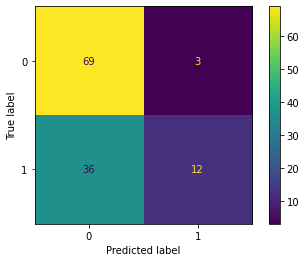Online ads
Contents
Online ads#
In this problem set we analyse the relationship between online ads and purchase behavior. In particular, we want to classify which online users are likely to purchase a certain product after being exposed to an online ad.
Setup#
import pandas as pd
import altair as alt
import seaborn as sns
from sklearn.model_selection import train_test_split
from sklearn.linear_model import LogisticRegressionCV
Data#
Import data#
df = pd.read_csv("https://raw.githubusercontent.com/kirenz/datasets/master/purchase.csv")
Data structure#
df
| Unnamed: 0 | User ID | Gender | Age | EstimatedSalary | Purchased | |
|---|---|---|---|---|---|---|
| 0 | 1 | 15624510 | Male | 19 | 19000 | 0 |
| 1 | 2 | 15810944 | Male | 35 | 20000 | 0 |
| 2 | 3 | 15668575 | Female | 26 | 43000 | 0 |
| 3 | 4 | 15603246 | Female | 27 | 57000 | 0 |
| 4 | 5 | 15804002 | Male | 19 | 76000 | 0 |
| ... | ... | ... | ... | ... | ... | ... |
| 395 | 396 | 15691863 | Female | 46 | 41000 | 1 |
| 396 | 397 | 15706071 | Male | 51 | 23000 | 1 |
| 397 | 398 | 15654296 | Female | 50 | 20000 | 1 |
| 398 | 399 | 15755018 | Male | 36 | 33000 | 0 |
| 399 | 400 | 15594041 | Female | 49 | 36000 | 1 |
400 rows × 6 columns
df.info()
<class 'pandas.core.frame.DataFrame'>
RangeIndex: 400 entries, 0 to 399
Data columns (total 6 columns):
# Column Non-Null Count Dtype
--- ------ -------------- -----
0 Unnamed: 0 400 non-null int64
1 User ID 400 non-null int64
2 Gender 400 non-null object
3 Age 400 non-null int64
4 EstimatedSalary 400 non-null int64
5 Purchased 400 non-null int64
dtypes: int64(5), object(1)
memory usage: 18.9+ KB
# inspect outcome variable
df['Purchased'].value_counts()
0 257
1 143
Name: Purchased, dtype: int64
Data corrections#
# change data format
df['Purchased'] = df['Purchased'].astype('category')
# make dummy variable
df['male'] = pd.get_dummies(df['Gender'], drop_first = True)
# drop irrelevant columns
df.drop(columns= ['Unnamed: 0', 'User ID', 'Gender'], inplace = True)
Variable lists#
# prepare data for scikit learn
y_label = 'Purchased'
X = df.drop(columns=[y_label])
y = df[y_label]
Data split#
# make data split
X_train, X_test, y_train, y_test = train_test_split(X, y, test_size=0.3, random_state = 1)
Data exploration set#
# create new training dataset for data exploration
df_train = pd.DataFrame(X_train).copy()
df_train['Purchased'] = pd.DataFrame(y_train)
df_train
| Age | EstimatedSalary | male | Purchased | |
|---|---|---|---|---|
| 39 | 27 | 31000 | 0 | 0 |
| 167 | 35 | 71000 | 0 | 0 |
| 383 | 49 | 28000 | 1 | 1 |
| 221 | 35 | 91000 | 1 | 1 |
| 351 | 37 | 75000 | 1 | 0 |
| ... | ... | ... | ... | ... |
| 255 | 52 | 90000 | 0 | 1 |
| 72 | 20 | 23000 | 0 | 0 |
| 396 | 51 | 23000 | 1 | 1 |
| 235 | 46 | 79000 | 1 | 1 |
| 37 | 30 | 49000 | 1 | 0 |
280 rows × 4 columns
Analyze data#
df_train.groupby(by=['Purchased']).describe().T
| Purchased | 0 | 1 | |
|---|---|---|---|
| Age | count | 185.000000 | 95.000000 |
| mean | 32.621622 | 45.821053 | |
| std | 7.957603 | 8.756735 | |
| min | 18.000000 | 27.000000 | |
| 25% | 27.000000 | 39.000000 | |
| 50% | 33.000000 | 47.000000 | |
| 75% | 38.000000 | 52.500000 | |
| max | 59.000000 | 60.000000 | |
| EstimatedSalary | count | 185.000000 | 95.000000 |
| mean | 58556.756757 | 89505.263158 | |
| std | 22429.073482 | 43284.038059 | |
| min | 15000.000000 | 20000.000000 | |
| 25% | 43000.000000 | 43500.000000 | |
| 50% | 60000.000000 | 97000.000000 | |
| 75% | 75000.000000 | 130000.000000 | |
| max | 134000.000000 | 150000.000000 | |
| male | count | 185.000000 | 95.000000 |
| mean | 0.518919 | 0.452632 | |
| std | 0.500998 | 0.500392 | |
| min | 0.000000 | 0.000000 | |
| 25% | 0.000000 | 0.000000 | |
| 50% | 1.000000 | 0.000000 | |
| 75% | 1.000000 | 1.000000 | |
| max | 1.000000 | 1.000000 |
Purchasers are (on average) _______ and earn a __________ estimated salary than non-purchasers.
Visualization of differences:
alt.Chart(df_train).mark_circle().encode(
alt.X(alt.repeat("column"), type='quantitative'),
alt.Y(alt.repeat("row"), type='quantitative'),
alt.Color('Purchased:N'),
).properties(
width=150,
height=150
).repeat(
row=['Age', 'EstimatedSalary', 'male'],
column=['Age', 'EstimatedSalary', 'male']
).interactive()
Code for seaborn:
sns.pairplot(hue='Purchased', kind="reg", diag_kind="kde", data=df_train);
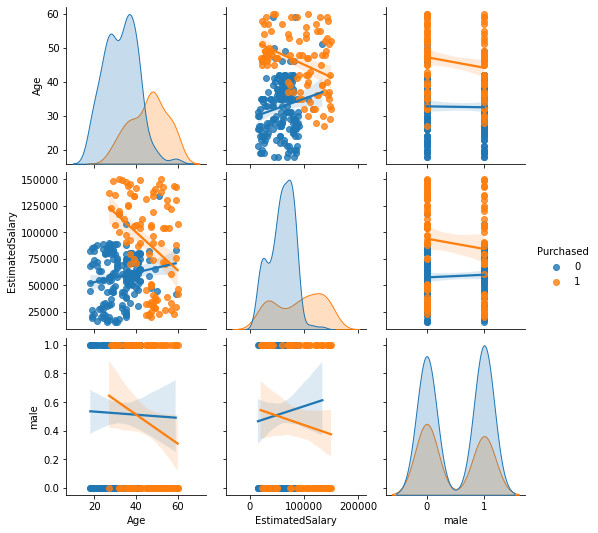
Inspect (linear) relationships between variables with correlation (pearson’s correlation coefficient)
df.corr().round(2)
| Age | EstimatedSalary | male | |
|---|---|---|---|
| Age | 1.00 | 0.16 | -0.07 |
| EstimatedSalary | 0.16 | 1.00 | -0.06 |
| male | -0.07 | -0.06 | 1.00 |
alt.Chart(df_train).mark_area(
opacity=0.5,
interpolate='step'
).encode(
alt.X("Age:Q", bin=alt.Bin(maxbins=20)),
alt.Y('count()', stack = None),
alt.Color('Purchased:N'),
).properties(width=300)
Code for seaborn:
sns.histplot(hue="Purchased", x='Age', data=df_train);
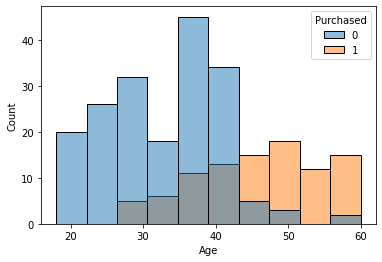
Purchasers seem to be _________ than non-purchaser.
alt.Chart(df_train).mark_boxplot(
size=50,
opacity=0.7
).encode(
x='male:N',
y=alt.Y('Age:Q', scale=alt.Scale(zero=True)),
color='Purchased:N'
).properties(width=300)
Code for seaborn
sns.boxplot(x="male", y="Age", hue="Purchased", data=df_train);
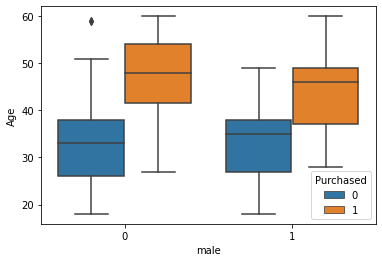
There are __________ differences regarding gender.
alt.Chart(df_train).mark_area(
opacity=0.5,
interpolate='step'
).encode(
alt.X("EstimatedSalary:Q", bin=alt.Bin(maxbins=20)),
alt.Y('count()', stack = None),
alt.Color('Purchased:N'),
).properties(width=300)
Code for seaborn
sns.histplot(hue="Purchased", x='EstimatedSalary', data=df_train);

Purchaser earn a ______________ estimated salary.
alt.Chart(df_train).mark_boxplot(
size=50,
opacity=0.7
).encode(
x='male:N',
y=alt.Y('EstimatedSalary:Q', scale=alt.Scale(zero=True)),
color='Purchased:N'
).properties(width=300)
Code for seaborn
sns.boxplot(x="male", y="EstimatedSalary", hue="Purchased", data=df_train);
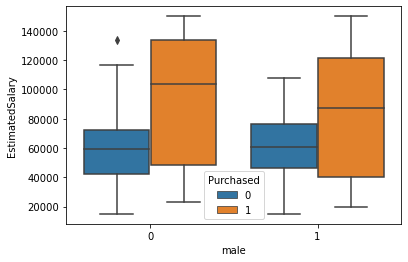
Insight: there are ___________ differences between males and females (regarding purchase behavior, age and estimated salary)
Select features#
# only select meaningful predictors
features_model = ['Age', 'EstimatedSalary']
X_train = X_train[features_model]
X_test = X_test[features_model]
Model#
Select model#
Next, we will fit a logistic regression model with a L2 regularization (ridge regression). In particular, we use an estimator that has built-in cross-validation capabilities to automatically select the best hyper-parameter for our L2 regularization (see the documentation).
We only use our most promising predictor variables Age and EstimatedSalary for our model.
# model
clf = LogisticRegressionCV()
Training#
# fit model to data
clf.fit(X_train, y_train)
LogisticRegressionCV()In a Jupyter environment, please rerun this cell to show the HTML representation or trust the notebook.
On GitHub, the HTML representation is unable to render, please try loading this page with nbviewer.org.
LogisticRegressionCV()
Coefficients#
clf.intercept_
array([-4.64629128])
clf.coef_
array([[7.57358038e-02, 1.72880947e-05]])
Classification metrics#
# Return the mean accuracy on the given test data and labels:
clf.score(X_test, y_test)
0.7833333333333333
from sklearn.metrics import ConfusionMatrixDisplay
ConfusionMatrixDisplay.from_estimator(clf, X_test, y_test);
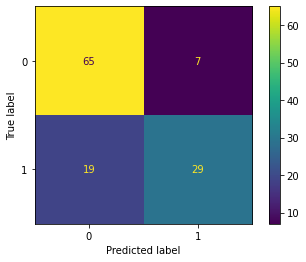
from sklearn.metrics import classification_report
y_pred = clf.predict(X_test)
print(classification_report(y_test, y_pred, target_names=['No', 'Yes']))
precision recall f1-score support
No 0.77 0.90 0.83 72
Yes 0.81 0.60 0.69 48
accuracy 0.78 120
macro avg 0.79 0.75 0.76 120
weighted avg 0.79 0.78 0.78 120
The (unweighted) recall of our model is _____
The (unweighted) precision of our model is _____
ROC Curve#
from sklearn.metrics import RocCurveDisplay
RocCurveDisplay.from_estimator(clf, X_test, y_test) ;
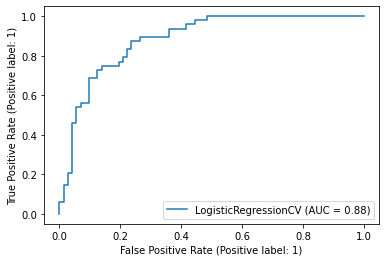
AUC Score#
from sklearn.metrics import roc_auc_score
y_score = clf.predict_proba(X_test)[:, 1]
roc_auc_score(y_test, y_score)
0.8842592592592593
Thresholds#
We use three different thresholds. Which threshold would you recommend if we want to maximize our F1-Score?
pred_proba = clf.predict_proba(X_test)
Threshold 0.4#
df_04 = pd.DataFrame({'y_pred': pred_proba[:,1] > .4})
ConfusionMatrixDisplay.from_predictions(y_test, df_04['y_pred']);
print(classification_report(y_test, df_04['y_pred']))
precision recall f1-score support
0 0.84 0.79 0.81 72
1 0.71 0.77 0.74 48
accuracy 0.78 120
macro avg 0.77 0.78 0.78 120
weighted avg 0.79 0.78 0.78 120
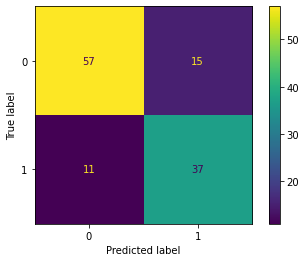
Threshold 0.5#
df_05 = pd.DataFrame({'y_pred': pred_proba[:,1] > .5})
ConfusionMatrixDisplay.from_predictions(y_test, df_05['y_pred']);
print(classification_report(y_test, df_05['y_pred']))
precision recall f1-score support
0 0.77 0.90 0.83 72
1 0.81 0.60 0.69 48
accuracy 0.78 120
macro avg 0.79 0.75 0.76 120
weighted avg 0.79 0.78 0.78 120
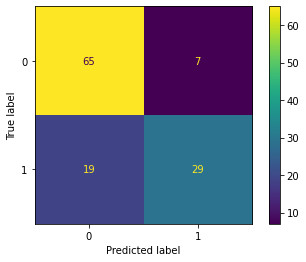
Threshold 0.7#
df_07 = pd.DataFrame({'y_pred': pred_proba[:,1] > .7})
ConfusionMatrixDisplay.from_predictions(y_test, df_07['y_pred']);
print(classification_report(y_test, df_07['y_pred']))
precision recall f1-score support
0 0.66 0.96 0.78 72
1 0.80 0.25 0.38 48
accuracy 0.68 120
macro avg 0.73 0.60 0.58 120
weighted avg 0.71 0.68 0.62 120
